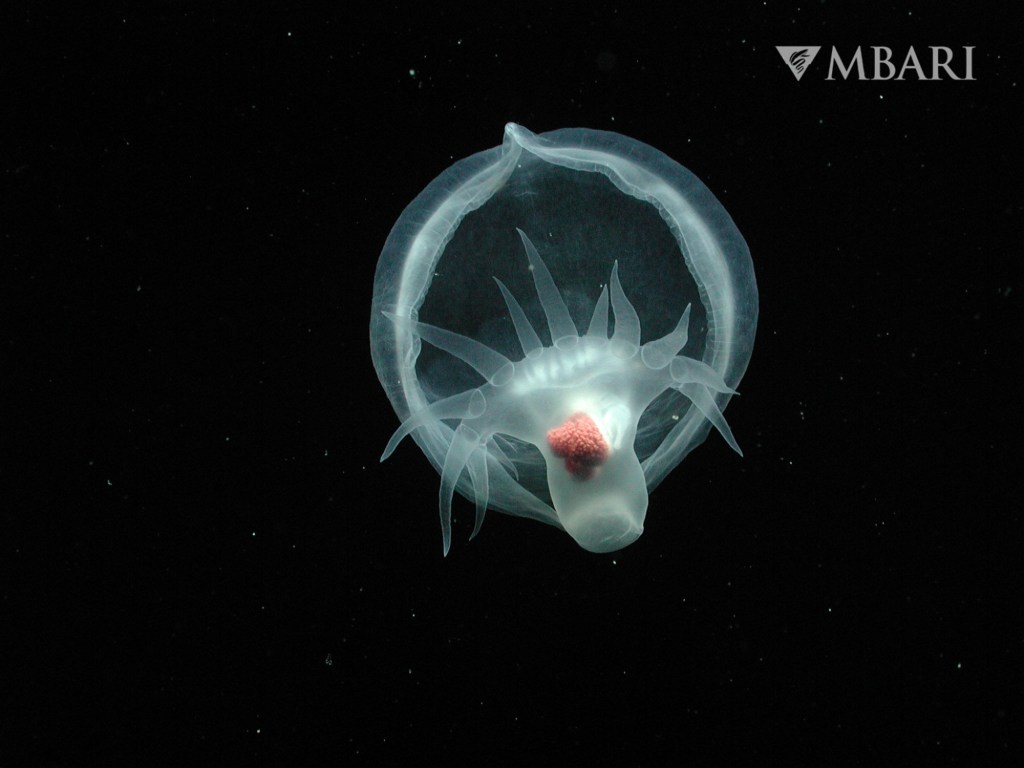Undulating deep in Monterey Bay, the translucent mystery mollusc defied characterization. On Tuesday, scientists at the Monterey Bay Aquarium Research Institute (MBARI) announced their discovery of these ghostly creatures as the first member of a brand-new family of nudibranchs (sea slugs) that floats through the water column instead of crawling along the seafloor.
The mystery mollusc, Bathydevius caudactylus, with its large jellyfish-like hood, snail-like body and finger-like appendages, defied expectations from the first sightings in 2000 from MBARI’s remotely operated vehicles. These custom vehicles survey the deep ocean doing everything from measuring water chemistry to looking for undiscovered species. Sightings of the mystery mollusc were rare, with 157 individuals observed over the decades.
And these individuals baffled scientists from the beginning. “It’s not very similar to anything else,” said Bruce Robison, senior scientist at MBARI. “When we first came upon it, we were all saying to each other, ‘What the heck is that?’ because we’ve never seen anything like it before.”

The mystery mollusc differs from its distant cousins in both genetics and anatomy. When comparing the genes that are similar between species, scientists can track small differences in a sequence to see how closely related two species are. The fewer differences, the closer they are related. While the mystery mollusc genes are most similar to nudibranchs, they differ significantly from those of their nearest cousins.
As for their anatomy, the hood is most similar to the lion’s mane nudibranch (Melibe leonina) that live in kelp forests in shallow water. But the combination of body parts of these deep-sea creatures resembles no other known animal. Between the genetic and anatomical differences, the mystery mollusc must be the first member of an entirely new family of species.
These slow-moving creatures use bioluminescence for defense — a strategy that counterintuitively deters predators within their pitch-black environment. Instead of lighting up their locations for all to see, bioluminescence “can startle a predator and make it swim away,” according to Robison.
Another possibility comes from the fact that the finger-like projections, called dactyls, also glow in the dark. “Those dactyls fall off like a lizard dropping its tail,” said Robison. “If they turn off the lights in the rest of the body, and just that glowing, wiggling dactyl is visible, then the predator may go for the decoy rather than the animal itself.”
As for its own diet, mystery molluscs fill their orange-red, semi-translucent stomachs with shrimp. Using oxygen consumption readings as a measure of metabolism, the researchers estimated that the animals need to eat roughly the same amount as similarly sized comb jellies and other jellyfish. Scientists never observed them catch their prey, but they did see some chowing down on shrimp pieces in their mouths.
As for mating, each animal has both male and female sex organs.
“In the habitat where they live, opportunities to find a potential mate are few and far between,” said Robison. “But you double your chances of success if both individuals carry both sets of sex organs.”
To date, no one has observed two mystery molluscs mating.
Despite living their lives undulating through the water, the mystery mollusc sinks to the sea floor to lay its eggs. There, the fragile creatures “grab ahold of it with their foot and release a ribbon of eggs,” said Robison.
Though the researchers generally avoid removing creatures from their natural habitat, they tried hatching a few of these eggs in their lab. The larvae did not survive to adulthood, so these creatures will not be joining the deep sea exhibit at Monterey Bay Aquarium in the flesh anytime soon. However, visitors can see a video about them while they view the more robust creatures living in the exhibit.
Not much else is known about these puzzling creatures.
“Monterey Bay is the best studied patch of deep ocean in the world,” said Robison. “And yet we’re still finding new stuff. Think what else is out there in the rest of the world ocean, waiting to be discovered.”

Originally Published:

















































